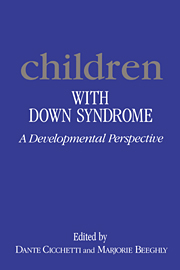Book contents
- Frontmatter
- Contents
- List of contributors
- Preface
- 1 Applying the developmental perspective to individuals with Down syndrome
- 2 An organizational approach to the study of Down syndrome: contributions to an integrative theory of development
- 3 Temperament and Down syndrome
- 4 Interactions between parents and their infants with Down syndrome
- 5 Attention, memory, and perception in infants with Down syndrome: a review and commentary
- 6 Sensorimotor development of infants with Down syndrome
- 7 The growth of self-monitoring among young children with Down syndrome
- 8 Early conceptual development of children with Down syndrome
- 9 Language abilities in children with Down syndrome: evidence for a specific syntactic delay
- 10 Beyond sensorimotor functioning: early communicative and play development of children with Down syndrome
- 11 Peer relations of children with Down syndrome
- 12 Families of children with Down syndrome: ecological contexts and characteristics
- 13 Early intervention from a developmental perspective
- Name index
- Subject index
8 - Early conceptual development of children with Down syndrome
Published online by Cambridge University Press: 02 November 2009
- Frontmatter
- Contents
- List of contributors
- Preface
- 1 Applying the developmental perspective to individuals with Down syndrome
- 2 An organizational approach to the study of Down syndrome: contributions to an integrative theory of development
- 3 Temperament and Down syndrome
- 4 Interactions between parents and their infants with Down syndrome
- 5 Attention, memory, and perception in infants with Down syndrome: a review and commentary
- 6 Sensorimotor development of infants with Down syndrome
- 7 The growth of self-monitoring among young children with Down syndrome
- 8 Early conceptual development of children with Down syndrome
- 9 Language abilities in children with Down syndrome: evidence for a specific syntactic delay
- 10 Beyond sensorimotor functioning: early communicative and play development of children with Down syndrome
- 11 Peer relations of children with Down syndrome
- 12 Families of children with Down syndrome: ecological contexts and characteristics
- 13 Early intervention from a developmental perspective
- Name index
- Subject index
Summary
Without the ability to categorize, a child's life would be chaotic, since his or her world contains an infinite number of discriminably different entities. Assigning objects or events or attributes to categories provides the child's world with stability: Each entity no longer must be treated as unique. Entities assigned to the same category are alike in important respects, and thus can be treated similarly. Categories also allow a child to go beyond the information perceptually available from observing an entity, to make inferences about that entity. Consider the case of an opaque object that is currently stationary. Once the category assignment of that object is known, a child can predict both the internal (invisible from the surface) attributes of the object and the functions or characteristic actions of the object (based largely on the correlated form attributes).
These points have been made repeatedly in the literature concerned with categorization by nonhandicapped human adults (e.g., Bruner, Goodnow, & Austin, 1956; C. B. Mervis & Rosch, 1981; E. E. Smith & Medin, 1981). Given the importance that has been ascribed to categorization, one would expect very young children to form categories spontaneously regardless of whether the children had Down syndrome or were developing normally. The purpose of this chapter is to consider the development of categorization by both children with Down syndrome and nonhandicapped children. Much of the chapter will focus on the results of a longitudinal study I recently conducted in collaboration with Claudia Cardoso-Martins and Cynthia Mervis (e.g., Cardoso-Martins, 1984; Cardoso-Martins & C. B. Mervis, 1984, 1988; Cardoso-Martins, C. B. Mervis, & C. A. Mervis, 1985; C. B. Mervis, 1982, 1984; C. B. Mervis & C. A. Mervis, 1984; C. B. Mervis, 1988).
- Type
- Chapter
- Information
- Children with Down SyndromeA Developmental Perspective, pp. 252 - 301Publisher: Cambridge University PressPrint publication year: 1990
- 12
- Cited by



